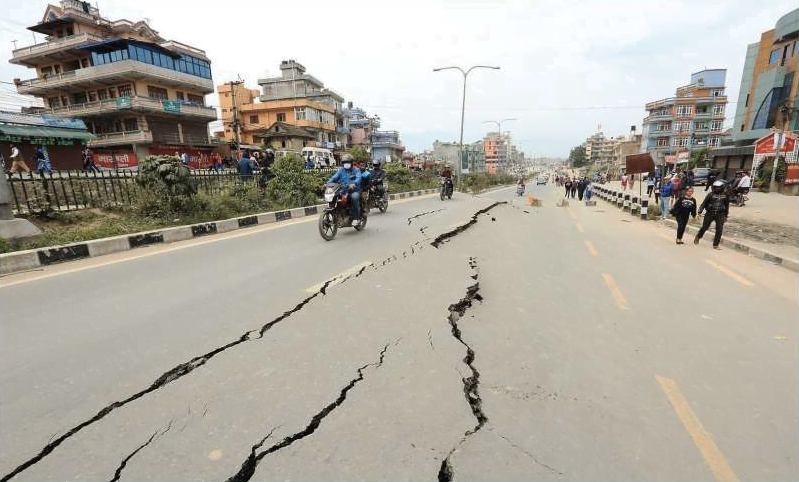The opinion piece originally appeared in the 2022 November Issue of New Business Age Magazine. Please read the original article here.
As a developing country in the global south, Nepal is one of the most vulnerable countries to climate change. Various reports have shown that it is often the lower-income countries that are at greater risk due to climate change as they have a lower capacity to adapt to the changes. While Nepal only contributes 0.027% of global greenhouse emissions, it is positioned high on the list of countries most vulnerable to the impact of climate change.
According to a report from the Asian Development Bank (ADB), Nepal could lose up to 2.2% of its annual GDP by 2050 due to the impact of climate change. The country has already begun to see the devastating effects of climate change like decreasing agricultural output, change in crop rotation, change in rainfall patterns leading to an increase in frequency of natural disasters including droughts, floods and landslides resulting in great loss of lives and properties. As a result, the government has been acting to ensure that the negative effects of climate change are minimised. The country is part of the Paris Climate Agreement and the government has been working to meet the Sustainable Development Goals by 2030. Investing in climate-resilient infrastructures is a major step that can be taken by the government to tackle this problem. Multilateral agencies such as the World Bank and the ADB have also been providing financial backing to the country for adaptation to climate change.
Climate-resilient infrastructure includes infrastructure that has been designed and built to prepare and adapt to the changing climate conditions. With climate-resilient infrastructure, the danger of risks emanating from climate-related disasters is reduced. It is important to note that building climate-resilient infrastructures will not completely stop the impact of climate change, but it will greatly mitigate the risks posed by climate change. In terms of impact from climate change, the rise in average temperature causing heat waves, the change in rainfall patterns leading to droughts, floods, and rainfall, and the threats of glacier lake outbursts are the few major threats that Nepal currently faces. The current and future infrastructures being built in the country should take these factors into account and build infrastructure that can minimise the damage caused by these threats. It is especially important for climate resiliency to be taken into account while developing new infrastructure projects because the government has been increasing investment in the infrastructure sector with an aim to accelerate the economic growth of the country.
Major infrastructure projects such as Nagdhunga tunnel, Sikta Irrigation Project and West Seti hydropower project are all under construction or are slated to start construction soon. If climate change effects are not taken into account for these projects, then the investment made into these projects may end up going to waste. Thus, factors such as the increase in temperature, the water level at river sources, and glacial movements should all be taken into account before starting these mega projects.
Climate resilience also includes the maintenance of the existing infrastructure so that they are less vulnerable to the impacts of climate change. Floods and landslides have been causing extensive damage to different infrastructure in the country. While rebuilding these damaged infrastructure, climate resilience should be taken into account. Some things that can be done include building proper drainage systems to decrease the impact of flooding, rebuilding roads that can withstand higher temperatures, and rebuilding residential buildings with adequate ventilation to combat the effects of rising temperatures. Building infrastructures that can support the growing population of urban areas including roads, proper drainage systems, and waste management systems was a major topic of discussion at the recently held Nepal Infrastructure Summit 2022.
As rising temperatures and subsequent droughts will increase the demand for water for irrigation and drinking purposes, reservoirs should be built to address these problems. The government should also increase the monitoring of the current infrastructure systems so that required maintenance can be done on time. The government and the private sector are also eyeing green hydrogen as an alternative to petroleum products and chemical fertilisers.
Multilateral partners have been providing support to Nepal for building infrastructures that are climate resilient. Recently, Nepal and the World Bank signed a concessional financing agreement for $100 million for Green, Resilient, and Inclusive Development (GRID) with an aim to support the sustainable and productive use of natural capital and resilience of urban and rural areas. Two further instalments of funds are slated to be available through this agreement. Asian Development Bank has also provided financial support to the government for tackling climate change. Last month, the bank provided $70 million in loans to improve livelihood and climate resilience of 30,000 horticulture farmers across five provinces. During his visit to Nepal in March 2022, ADB’s Director General for South Asia Kenichi Yokoyama mentioned that the bank would maintain financial support amounting to $500- 600 million per year for the next three years for supporting the government’s aim of achieving sustainable growth.
Although the government has taken steps to create climate-resilient infrastructure in the country much is yet to be done especially in regards to management of the climate resiliency of the existing infrastructure. In addition to focusing on the climate-resiliency of newer infrastructure projects, the government needs to create solution-oriented policies that can minimise the negative impact of climate change on existing infrastructure. Further, instead of just taking loans from the development partners, the government needs to find other sources of funding as the burden of paying the debt is ultimately passed on to citizens impacted by climate change.
The concept of climate reparations could be applied here. The concept is a call for money to be paid by Global North to Global South to address the historical and current contributions made by Global North to cause climate change. Thus, the Nepal government could evoke this concept to request the development partners to provide grants instead of loans to combat the negative impact of climate change. Mobilising domestic funding through implementation of green financing can also be another option of raising funds.




